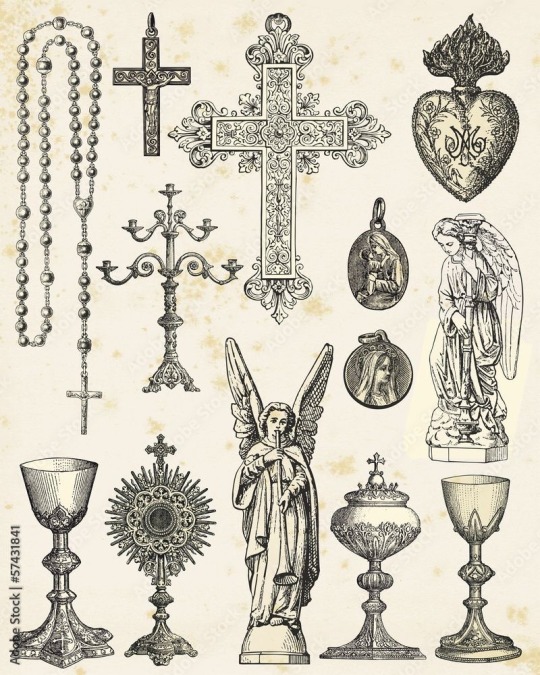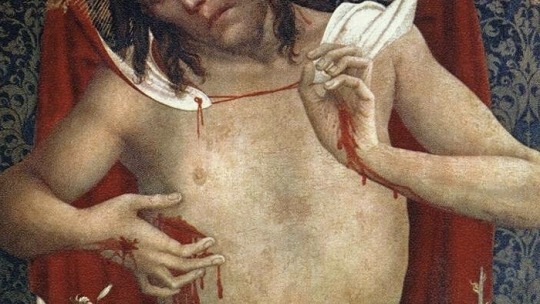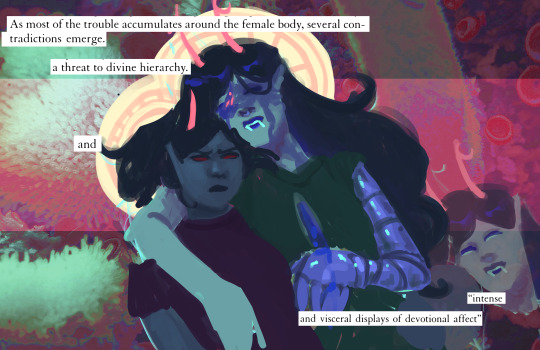#religious motifs
Explore tagged Tumblr posts
Text

Okay, hear me out:
I feel that we need fanfics about Baldwin IV that emphasize on his religiosity more. And I swear I’m not saying that just because I am a (leftist) Catholic
Don’t get me wrong, I love a lot of works out there, but I’d love to see a time-travelling Baldwin getting shocked about how much the liturgy has changed. Like where the heck did the Gregorian chant go
Baldwin learning about Protestantism and other Christian denominations born during the Renaissance and after. Like Mormonism and Jehovah’s witnesses who technically are not even Christian anymore
Baldwin learning that Roman Catholic mass is now celebrated with the priest standing in front to the congregation
Baldwin teaching some Catholic f*scists their place (so satisfactory)
And finally, cherry on top, Baldwin learning about babies being baptised with holy water from a toy pistol during the pandemic because of c*vid restrictions!!
#kingdom of heaven#koh fandom#koh#baldwin iv#king baldwin iv#Baldwin IV x reader#koh fanfiction#kingdom of heaven fanfiction#koh headcanons#religious motifs#just giving some Catholic advice lol
52 notes
·
View notes
Text

This drawing made me realise that actually I love the comfort zone and I would like to go back into it. Also that I must draw more tigers.
#ok not really but I’ve had a headache for three days because I’m on such a time crunch gahhh#portfolio struggles etc etc#original art#my art#artists on tumblr#digital art#art#angels#I looooove angels#I have no religious background at all I just adore them as motifs as symbols as whatever#they’re so cool#cats
38K notes
·
View notes
Text
St. Mary's Church in Sandholt

St. Mary's Church is a beautiful medieval church located on a hill overlooking the quaint village of Sandholt. Built in the Gothic style, the church is a magnificent structure with a commanding presence that can be seen from all around the village.
As one approaches the church, its bell tower is the first feature that draws the eye. Rising high into the sky, the tower is adorned with a variety of decorative features, including intricate stonework and delicate tracery.
The main entrance to the church is through a grand set of wooden doors, which are carved with a variety of religious motifs and scenes. Upon entering the church, visitors are immediately struck by the sheer size and grandeur of the interior. The high ceilings and soaring arches give the impression of an immense space that seems almost to stretch towards the heavens.
The church is decorated with a variety of beautiful stained-glass windows, many of which date back several centuries. These windows depict a variety of religious scenes and motifs, and they are a true testament to the skill and artistry of the medieval craftsmen who created them.
The church is still in use today, and it is a popular destination for both tourists and locals alike. Services are held regularly, and visitors are welcome to attend and experience the beauty and serenity of this ancient house of worship.
Overall, St. Mary's Church is a magnificent and awe-inspiring structure, a testament to the skill and artistry of the medieval craftsmen who built it. It is a true jewel of the village, a symbol of its deep religious roots and its enduring connection to the past.
#St. Mary's Church#Sandholt Village#Gothic architecture#stained-glass windows#religious motifs#history#artistry#craftsmanship#religious roots#serenity#worship#medieval craftsmen#bell tower#entrance#arches#Christian art#religious scenes
0 notes
Text


#religious motif#religious imagery#religious art#ethel cain#girlblogging#coquette#lana del rey#femcel#girlblogger#lana del rey aesthetic#lizzy grant#southern gothic#southern goth aesthetic#southern gothic aesthetic
715 notes
·
View notes
Text

(detail from ‘The Incredulity of Saint Thomas’ c. 1600s by Guercino) (detail from ‘Jesus and Doubting Thomas’ c. late 1700s early 1800s by Franciszek Smuglewicz) (detail from ‘Bacchus and Ariadne’ c. 1720s by Giovanni Antonio Pellegrini) (detail from ‘Kriemhild’s Accusation (Kriemhild accuses Gunther and Hager of murdering her husband Siegfried)’ c. 1879 by Emil Laufer) (detail from ‘The Virgin of the Rocks Louvre version’ c. 1483-1486 by Leonardo da Vinci) (detail from ‘The Incredulity of Saint Thomas Secular Version’ c. 1602 by Caravaggio) (detail from ‘The Creation of Adam’ c. 1512 by Michelangelo) (detail from ’The Unequal Marriage’ c. 1862–1862 by Vasili Pukirev) (detail from ‘The Death of Seneca’ c. 1615 by Peter Paul Rubens) (detail from ‘Mary Stuart and William II’ c. 1641 by Anthony van Dyck) (detail from ’The Fortune Teller’ c. 1594 by Caravaggio) (detail from 'The Arnolfini Portrait' c. 1434 by Jan van Eyck) (detail from ‘Pieta’ c. 1876 by William Adolphe Bouguereau)
#art history#hand motif#art gif#gif#my gif edit#renaissance art#tw flashing#religious imagery#does this count as art?#took me long enough#art
147 notes
·
View notes
Text
Dungeon and daddies spoilers ahead

The doodler being made corporial had such a clear image attached in my head, Anthony described it so well so here it is in a stain glass window like format.
#dndads#dungeons and daddies#scary marlowe#scary marlow#the doodler#cw vomit#cw eyestrain#cw eye horror#cw eye imagery#my art#im a sucker for eye motifs and religious imaginery so this was a clear conbo#i struggled with the colors#i dont usually do clear lineart but i think it looks okay#anyway i need to go to bed#dndads spoilers
917 notes
·
View notes
Text

Still thinking about this idea from @tazova
I am smooshing the idea together with a party setting in my brain and I can picture the spicy comic already ☺️
Patreon
#gaalee#leegaa#fanart#fan art#autumns disaster art#gaara x rock lee#gaara#rock lee#angel demon au#is it obvious I love religious motifs or#I tweaked the dynamic of the matching up a bit in my head#I have lots of art to post#but my ideas these days are very niche lol#my poor patrons
48 notes
·
View notes
Text
catholic guilt is one thing but southern baptism shame is a whole different monster i don’t see many people talking about
#thoughts#i get tired of certain religious narratives written by people#where they take the aesthetics and the motifs and the idea of Christianity#but it’s kind of a surface level exploration of religious guilt#southern baptism shame. and ive seen this. genuinely makes people want to kill themselves#would love to write about it one day#not to say one is worse than the other but if you grew up around fire and brimstone people like i did youd Understand#it is a very specific pain. especially if you somehow deviate from the very small box you are expected to be in#that kind of shame DOES kill#southern baptism is very very evil. and the Bible Belt is a very evil place to live sometimes because of it.
42 notes
·
View notes
Text
i occasionally remember that the chorus to our lady of sorrows is the dies irae ray toro the man you are
#mcr#my chemical romance#ray toro#gerard way#frank iero#mikey way#a chorus asking you to trust him backed by the musical symbol for death#plus the religious origins of the motif#ughhhh
32 notes
·
View notes
Text




House M.D. 02x24 “No Reason” / Meister Francke, Man of Sorrow, with Angels / Peter Paul Rubens, Lament of Christ
#give me House religious motifs or give me death#house side wound…. no further comment#house Md#Gregory house#parallels#greg house#web weaving#lee postz#comparatives#house#peter paul rubens#meister francke#art#religious art#houseedit#housemdedit
185 notes
·
View notes
Text

Sometimes being in love is like getting your eye gored in a fit of purifying violence, sometimes it's not
#I keep talking about the romance of cannibalism so much my mother has gotten so so so tired of me (my friends are more mixed)#but also she got me to watch The Hunger (1983) which was very fun and very 80s#its about consuming and being consumed!!!!!!!!!!! Eating your loved one because you cannot stand them existing outside of yourself!!!!!!!!!#being eaten because you cannot stand existing outside of your lover!!! Becoming obsessed with literally merging together in the goriest way#basically I cannot stop thinking about Hannibal (2013)#I couldn't figure out how to get Tz's horn to fit with the way I placed their heads and then I realized wough........it would be going righ#in Vris's eye if I keep their heads where they were so I just leaned in bc themes......motifs..........symbolism................#blinding and being blinded is so central to their narrative ya know#anyway. this is an unhinged amount of tags I hope you had fun reading all of them#vriska serket#terezi pyrope#vrisrezi#homestuck#hs#my art#fantasy blood#religious imagery
347 notes
·
View notes
Note
In what context would you have effigies of evil spirits? Or objects carrying curses in general
I haven't really specifically invoked folk religious practices in the Wardi sphere (though a lot of what I've talked about includes it), a LOT of stuff revolving around curses is derived from folk magic traditions.
Folk religion here means magical/spiritual practices that develop out of common practice and may be Informed by religious doctrine but not Controlled by it. The Faith of the Seven Faced God is a state religion, but its broader sphere includes dozens of folk traditions (some heavily informed by and interactive with core doctrine, and some that are very distinct from core doctrine and have developed independently, or are heavily syncretic with foreign practices, older Wardi practices, or those of other native groups).
There's also major separation between the practices of priesthoods and lay folk (even in the urban context in which religious authority is based). This divide is fairly stark across class lines (as the upper classes are heavily integrated with the priesthoods, and Most priesthoods take their members from nobility (with Galenii being the only major exception)). However, virtually all members of society will include Some folk religious aspects in their practice. For example, the wearing of skimmer-woman amulets is Not derived from official doctrine, it is Not a canonical representation of Pelennaumache (with whom it is usually associated) this is just a very widespread folk practice (to the point that many priests wear them too). The Faith of the Seven Faced God is not proselytizing and prioritizes core orthopraxy being maintained (both on a public and private level, but the private levels are not actively policed). So these folk practices are not condemned unless they outright defy/supercede expected elements of practice.
This is the context for a lot of what I'm talking about wrt curses and magical practices outside of official rites. So like, belief in curses and evil spirits is basically ubiquitous in the Imperial Wardi cultural sphere, but folk traditions have unique ways of dealing with these threats (or inflicting these threats upon an intended target) while religious doctrine attempts to address these via blessings and public rites.
So to actually answer the question: a very common folk religious practice is to produce effigies of an offending evil spirit as means of confronting it. Some variants attempt to specifically trap it within the effigy in order to contain or destroy it, others attempt to wield power over it via the effigy (sometimes to destroy it, sometimes to redirect it to another target). Other effigies representing evil spirits in general are used to scare off real ones (the hats of the new years dancers are an example of this that has found a place in official public rites).
Attempts to cast spells and inflict curses usually involves objects as mechanisms. This most commonly comes in the form of writing your intent on a small object (frequently pieces of broken pottery, which is easy to come by) and then burying or hiding it in a secure and relevant location (ie- a curse or love spell might be buried near the home of your target). If it's targeted, parts of the other person's body (most commonly hair, best case scenario blood) will be bound to it in order to direct the spell. Somewhat lazier curse and spell attempts involve scrawling your desired effect onto a public wall as graffiti. The outer walls of temple grounds are sometimes targeted specifically for this purpose in hopes of getting God directly involved (this is Not Condoned, though will not get you executed like defacing the temple itself).
Other methods involve attempting to imbue a nondescript object with the intended curse/spell (often in order to get it close to the target without being questioned). This often integrates aspects of traditional medicine, using the Essence of various items (plants, animal parts, minerals, etc) to imbue an object with their effect (usually while speaking your intended spell/curse. Some folk traditions involve animal sacrifice to work magic- the animal is killed in offering to one of God's Faces (which are often interpreted more like a pantheon in common practice, especially those distanced from religious centers) so that the deity will perform the desired effect, imbue an object with the desired effect, etc. This IS condemned as heretical- official doctrine holds that ONLY priests can perform killing sacrifices, a layman does not have the necessary education and practice to do so properly, and attempting to is at best disrespectful and at worst spiritual defacement to the body of God (which the animal becomes at the moment of death). (Laymen can buy or provide animals to be offered on their behalf, but themselves can only offer their own blood or food/drink/flowers/incense/etc). It's particularly heretical when done to inflict curses - doctrine holds that God does not curse and only maintains order and blesses, curses and other spiritual harm come from being partly severed from God's influence and/or disruption of the body's living spirit (something all people are susceptible to). Laymen (and unofficial priesthoods/sects) sometimes do this regardless in secrecy (and it's very common in rural parts of the region with little access to religious centers), under the belief that this will make their magic substantially more powerful.
Bottom line is there are all sorts of methods to make cursed objects, so it's pretty common that people will find objects suspected of being cursed (or that actually Have been placed with intent to inflict a curse/spell), and in that context need methods of breaking the curse. Blessings from a priest are thought to dispel most common attachments to the body, but this is not always accessible and the object itself must be neutralized. This is sometimes accomplished by simply Putting It Somewhere Else so it becomes another person's problem, but there's a chance that the curse could be highly directed to oneself (maybe bound with your hair or etc). Most practices include a combination of neutralizing, destruction, and purification. Neutralizing is done via deflection (like the method mentioned in the prev post, though there are many other strategies), at which point the object may be safely destroyed. Lingering attachments are removed through self purification (at the most basic, this is performing one of the gestures against evil and bathing oneself).
The wearing of most apotropaic amulets hope to prevent curses from reaching their targets from the get-go. The pelatoche works to deflect the evil eye and minor evil spirits and curses, the phallus imbues masculine protection of the sanctity of the body, transforms bad luck into good, and threatens reprisal for curses. etc. These kinds of amulets are worn on all levels of society, but tend to be relied upon more fully by the upper classes (which are more closely looped in with the priesthood/state religion). Someone like Janeys wears at Least one pelatoche amulet constantly for protection but thinks most other folk-magic attempts to dispel curses are silly commoner superstitions, any harm that cannot be prevented by this sort of protection needs an official blessing and purification to be dispelled.
#There are major largely class based divides in how religion is practiced but the divide between perceived Correct Practice and#Silly Commoner Superstition is often very arbitrary and circumstantial- not even based in core doctrine.#Like wrt the pelatoche- this is a very widespread folk practice and not an aspect of official religious doctrine (though the motif Has been#adopted for use in some priesthoods). This is just one of the folk magic traditions that has been widely adopted across class levels and is#therefore Not Silly Commoner Superstition
20 notes
·
View notes
Text

Time to share another one wip! I’m doing a painting for the first time in years, so we’ll see how it goes! So far I’ve only done the colour blocking
#art#my art#wip#artists on tumblr#dnd#Nova#been wanting to do a painting of Nova with religious symbolism#since I used a lot of religious symbolism in her story#with her being the first sinner of the world I wanted to use eve and the apple as a motif#but there’s no snake because the only person who tempted her was herself#she also has a tendency to portray herself as a god where we are currently in the story so thats why I did the drapery and hand positions#thats my ramblings for today haha
46 notes
·
View notes
Text

Guilty
or biblically accurate Taemin
#shinee fanart#taemin#shinee taemin#lee taemin#tw eye horror#tw ommetaphobia#art by epiphany#userdimple#raplineuser#annietrack#I’ve heard taemin has a lot of religious motifs in his MVs#so I had to do my own spin#anyways this was a super quick sketch#but i like how it turned out
20 notes
·
View notes
Text



#religious motif#religious imagery#religious trauma#catholiscism#recovering catholic#girlblogging#coquette#lana del rey#lizzy grant#lana del rey aesthetic#femcel#girlblogger#ethel cain#taylor swift#southern gothic
215 notes
·
View notes
Note
Religious trauma anon again! Im genuinely serious when i say hes been a major sort of comfort, especially as someone who has one side of family that is catholic, and the other evangelical. The imagry you use is fantastic especially in your more thematic and symbological pieces, i love picking out the different aspects like where bandages and wounds are placed, what kind of background may be going on, the colors and the emotions associated with them, etc. Even if its not all intentional, its good food
.
#ahh thank you!#I love it when folks look at my art with intent and try to analyze it#themes motifs symbolism overtones and whether there's something to be read between the lines#I do consider details carefully more often than not and quietly hope that maybe someone catches the implications I'm not saying out loud#it's very flattering that you consider my art worth your time like that#religious trauma can be extremely rough I don't know you or what you've gone through but I hope you're doing better nowadays#answered#anonymous
183 notes
·
View notes